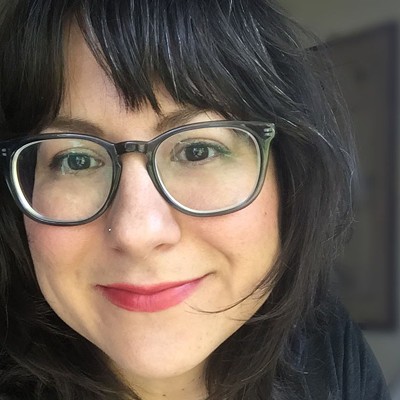Jenna Balfe climbs through mangroves. Her strong, lean body weaves through the intricately tangled branches. This is her art, her dance, and her healing. She knows that she probably won't fall, but if she does, Balfe, a clear-thinking, creative individual, will take whatever shit situation befalls her, learn from it, and use that new knowledge to help other broken people mend.
For a few years now, Balfe has been committed to her Body Movement class. "I don't want it to be like a normal dance class," she says. And it certainly isn't. Each lesson allows regular folks, as well as those more in tune with their physicality, to explore their and each others' bodies, the space they occupy, and a natural environment. Balfe calls these free classes democratic, adding that the students are oftentimes teachers, that she's merely providing the place and some guidance. But that would downplay her very important role in this complex project, one that continues to evolve with an upcoming performance, People/Trees/Here, taking place in a Coconut Grove mangrove forest.
A dancer, artist, aspiring yoga instructor, activist, and future grad student, Balfe also does work in the community to improve the overall environments in which we reside. She's on the board of Urban Environment League and works full time with developmentally delayed adults at Nature Links for Lifelong Learning. She assisted in creating the program with professor Greg Bush and currently teaches students about living healthy lifestyles, cooking, and tools to eventually gain independence.
Balfe herself is a Miami native who is soon heading off to Pratt Institute in Brooklyn to study dance movement therapy. She attended undergrad at UMass Amherst creating her own concentration focused on dance and environmental studies: Movement as a Form of Healing. Not only was it about body work, but, she explains, "I related it to the natural world. That's a huge element missing from most peoples' lives."
As an only child in a difficult living situation, she found nature therapeutic. Her mom is a paranoid schizophrenic and her dad was bipolar and severely depressed. She explains that without siblings, she was always making up games for herself. "There's no one there to kick you or dunk your head in the toilet, so you've gotta do it yourself."
She remembers being taken out of school and locked in her house for a year and a half. And though her dad helped her escape sometimes, she was truly trapped. "I was just always trying to get out. It was just me, my soul. I didn't like a/c. I'd shove shit in my a/c vents. I brought plants in my room, broke the windows so they would grow through them. I'm like a little animal," Balfe admits. "I just liked to take off and explore because it kept me sane." And while others might succumb to drugs or other dark forces in similar situations, Balfe rather used these experiences to fortify herself and others.
"I have gone through it, and (her lessons) are some things that have helped me get through some fucked up shit. I want to share that with others. People who have had hard lives have something to give people who haven't, because they see something. Everything that happens, there's a reason for it, and you have something to share because of it. And that's the little thing I have to share, that my crazy-ass went through some tough things and had to search to figure my way out."
Two serious car accidents in recent years threatened to impede upon the progress of both her yoga practice and her art. She found these hurtles taught her a lot about healing herself and gave her a whole new level of sensitivity to others' limitations.
Even with all of that, there's nothing doom or gloom about Balfe's work. She does admit though that, "I'm into that, intense, personal, and conceptual work," but she truly values elements of play.
"I think that the most intelligent people are the most playful people. They're open to being engaged and fun and dancing. If you can't do that, you're missing out on a huge part of life. I focus on that, on getting people out of their thing and getting them to play." In her Body Movement classes, she wants people to just be with each other, to know that it's OK to touch one another. "Once you realize it's fun and easy, you realize, you can do it, anyone can be a dancer. Everybody can be physical. We all want to touch each other, it feels good to be touched." One of the artist's more wild and interactive games of art, if you will, took place at Miami bar Gramps. The Rainbow Butt Race included ass-less pants worn by participants, strangers painting their bottoms as rainbows (or something like them), and then racing to place asses on the wall. Art, friends, can be fun.
While attending undergrad in Northampton, MA, her plan was always to continue the work of healing through movement in nature back in her hometown. She started out with the help of nomadic art collective SPRING BREAK/the end who provided her with space to host Body Movement classes. And because it was indoors, she notes, "It was more focused on movement, movement with other bodies, improv, and getting people to be creative and physical and interact with each other, and be present."
Most don't think daily about how they affect the space around them. Personally, when I took her classes, I didn't even really think you could get that philosophical about walking and it not be boring. She speaks of being aware of your breath, your rhythm, while strolling. "You start connecting to yourself and you realize, I can connect to myself at any point in time."
Balfe takes the mundane and explores the complexity of it using exercises like contact improv, which requires a lot of physical touch with strangers. She notes, "It's about breaking the boundaries and conventions of human interactions."
Though she was pleased with the work she was doing, she felt the missing element of nature had to be added to complete the project. "The full picture is relating to the earth and getting people to connect so that they can have context. (The natural environment) is our context, and we're very separated from it for different reasons." Her Body Movement classes have taken place in the mangroves at Kennedy Park for a few months now, and thus, in context.
"I chose the mangroves because they are really specific to our place in the world. It's a rare ecosystem, it doesn't just pop up anywhere. It's what holds our landscape in. They're barrier plants, they protect us during hurricanes," she explains, "Moving in them — it's like, really important as a Miamian to recognize this very special forest, and be present in it, and pay respect to it."
Last year, Balfe planned and performed a complex dance piece for the Miami Performance Festival called Dance Not Fiction. It was her first time making work with a lot of dancers, and she says she learned quite a bit. She was in relationships of sorts with all those who danced in it — an ex-boyfriend of 7 years, a new lover, all intense connections. It was about "finding the dance of them," she says, and allowing the audience to engage. She found that it was difficult to explain the web of relations to the audience and is now working to make future work clearer in this aspect.
And she'll have the opportunity to put these lessons into practice before she heads to Pratt next month. This Friday, with the help of friends, Balfe will perform People/Trees/Here. This includes folks who attended her Body Movement classes (Ganesha Michael Shapiro, Crystalle Caceres, Mauricio Abascal) and her good friends, the trees in Kennedy Park. "It's a particularly old mangrove forest. It's at least 100 years old. It's an old, gross forest, right next to an urban area, which is an important factor for the piece itself. It addresses that dichotomy — nature and the stuff that we build."
Ewa Josefsson and Katie Cora Stirman are two other main dancers working on the project. "Ewa is a yoga teacher and Katie is a dancer who has a lot of knowledge about modality of movement. It's been a process of learning from each other while using the mangroves as a guide, using their strength. The mangroves teach you how to trust and move. When you get in there, you can get into a zone because of the way they're structured. I find they're a therapeutic tool to get people to open up and trust their instincts."
Dennis Brewster Fuller, David Bennet, and Doug Webber will provide the music and artist Bhakti Baxter is building a set outside the trees with which they will interact.
The message of People/Trees/Here is about nature, but not an idealized nature that no longer exists. She says, "Let's not take it too fucking seriously. Let's deal with it, enjoy it, move through it, lessen the degrees of difference between a built environment and the natural environment, make them more similar to each other, have a similar approach as a human, as a living thing. It would help us a lot as a society, how we build things and live in things." The performance gives the mangroves new meaning and allows us homebodies the chance to open up and become exposed to the real world. And then let it heal us.
People/Trees/Here, 7 to 8 p.m., Friday, July 11, at Kennedy Park, 2600 S. Bayshore Dr., Coconut Grove, by the volleyball courts at the north end of the park. Parking available on both south and north sides of park off Bayshore. Donations are welcomed. Visit Facebook.
New Party Rules for Millennials
Top 20 Sexiest R&B Songs from the '90s to Today
Ten Best Florida Metal Bands of All Time
Ten Most Annoying Drunk Dudes You Meet at a Bar
Follow @CountyGrind











